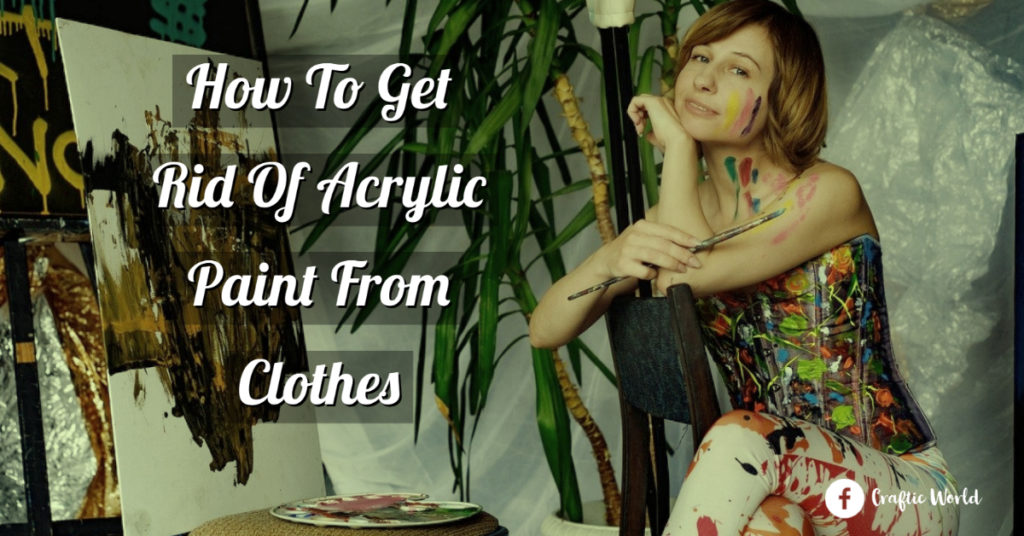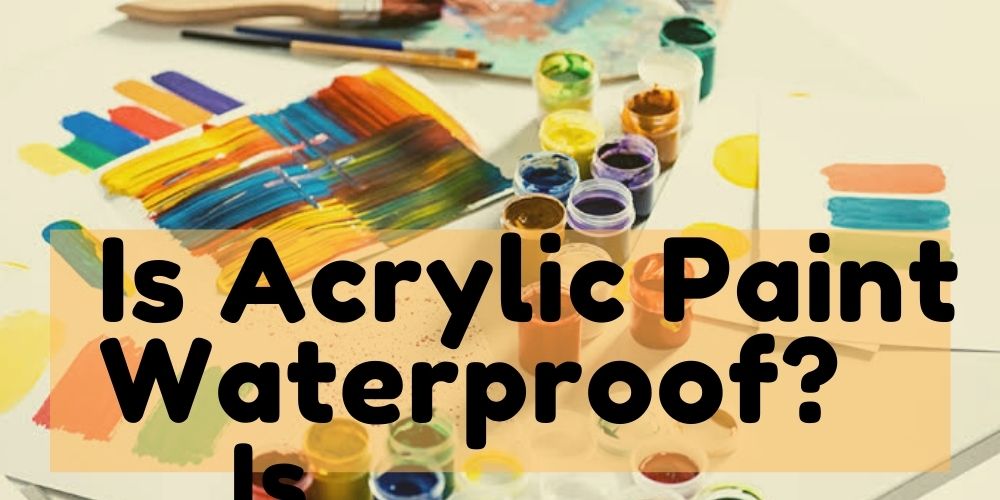Presently, there have been different types of colors available in the market. Therefore, with the wide range of painting options, we are left wondering which option is the best for our project. Also, watercolor and Acrylic paints are the two popular paints available in the market. Both are good options for beginner’s learning. However, both have differences in how you use them.
Here I will discuss watercolor vs acrylic paint topic in detail. In fat, the differences among these two paint types vary from usability, texture, color, surface, and various other factors. Thus, the joy of painting is to choose a different medium to work beyond limitations.
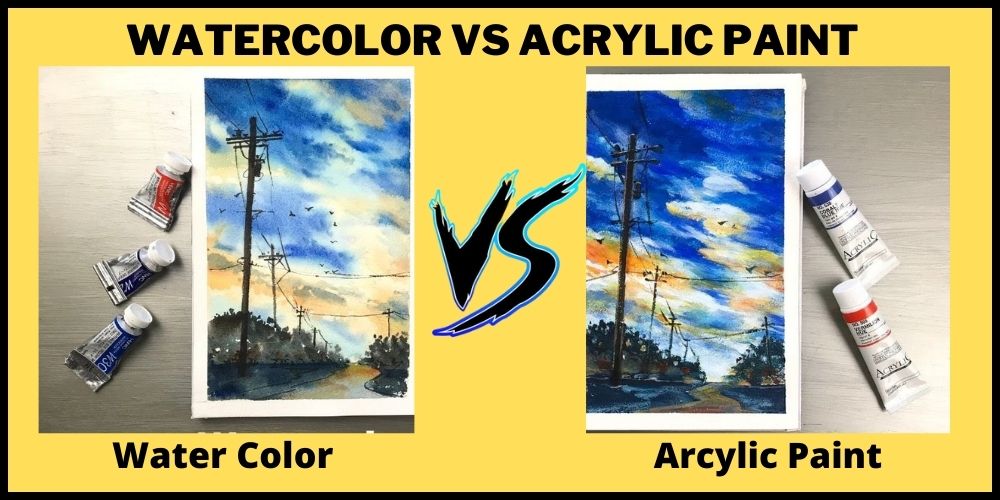
So, if you are looking for some beginner’s painting option, both watercolor and acrylic paint can work the best for you. Hence, choose wisely that can make you fall in love with your paintings.
What is an Acrylic Paint?
Acrylic paint is a fast-drying painting color.
They are usually water-based but made of pigment suspended in acrylic polymer emulsion. Also, it becomes water-resistant when it gets dry. Acrylic paints have a direct impact on Air dry clay, Canvas, Plaster, Wood, Cardboard, Stone, White Paper, and Polymer Clay.
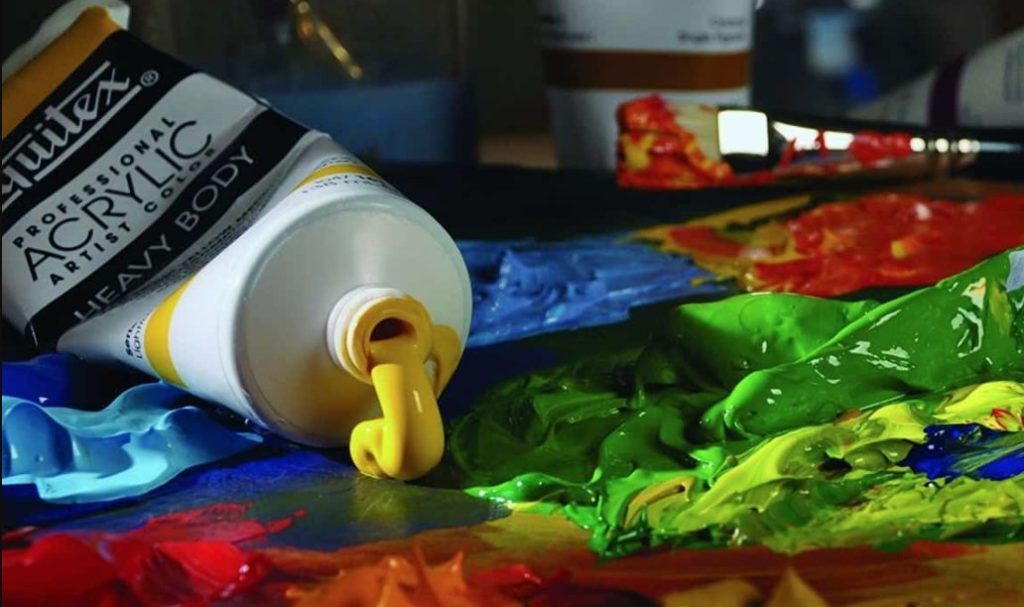
They are also made from other composite particles taken from silicon oils, stabilizers, metal soaps, defoamers, and plasticizers.
However, depending on the water consistency, acrylic paint can be formed in pastes and mediums. Also, the final outcome of the acrylic paint can resemble an oil painting, a watercolor, and a gouache. On the other hand, acrylic painting is considered the easiest medium for beginner’s painting.
Pros of Acrylic Paint
✅ Fast-drying.
✅ It is the easiest medium for beginner’s painting.
✅ It creates an interesting texture.
✅ It is water-resistant once dry.
✅ Non-toxic and safer for children to use.
✅ It can be cleaned or removed with water and soap.
✅ It is more flexible & cost-effective
✅ The pigments are vibrant.
Cons of Acrylic Paint
❌ You end up with a darker color of what you paint.
❌ Since it’s fast-drying, you need to work fast with your painting.
❌ Once dried, it becomes difficult to remove or clean from the brushes, clothing, and nails.
What is an Watercolor?
Watercolor is a traditional painting method that is aquarelle. It is a water-based solution that is made from suspended pigments. It consists of some basic ingredients such as glycerin, Arabic gum, pigment, and solvent. They usually come in the transparency form to create rich compound colors.
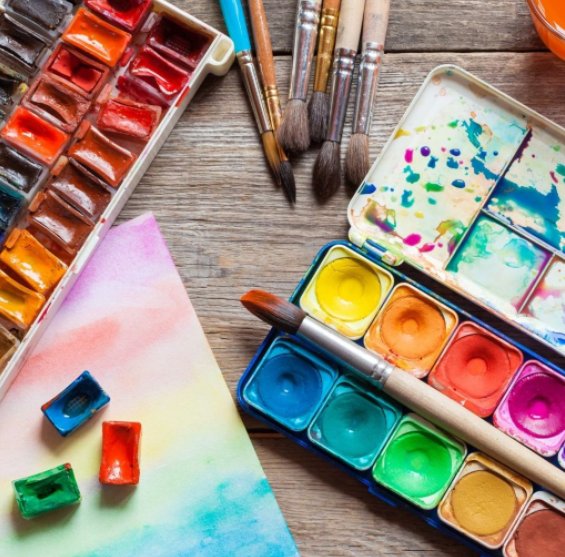
However, there are various techniques involved in watercolor painting. You will require various brushes in different shapes. Also, a plastic palette is required to mix different colors for painting. However, painting with watercolor is easy to use. You need to add water to create a rich complex of colors.
When mixing the color with water, it will look intense or darker on the palette. However, when it gets dry, it will look paler and lighter on the paper.
Pros of Watercolor
✅ The cleaning process involved is simple and easy.
✅ Your furniture, clothes, and skin is easy to clean up with water.
✅ It is less wasted paint.
✅ Non-toxic and safer for children to use.
✅ Inexpensive.
✅ It is transparent in texture.
Cons of Watercolor
❌ Using watercolor could be challenging that requires a lot of practice.
❌ The painting with watercolor has to be protected from sunlight to prevent fading.
❌ Must have control over the brush and the thickness of the liquid.
❌ Correction to the painting is difficult.
❌ Waiting time for drying is longer, and hard to work with larger works.
Watercolor vs Acrylic Paint: All the Main Differences Listed
Though Acrylic and Watercolor are water-soluble, yet the paints have several differences among them. Since Acrylic color is fast-drying, the color cannot be reused again.
On the other hand, watercolor can be reused over and over again by adding water to it. Hence, the differences among both the paints can be identified in different aspects. Let’s settle this watercolor vs acrylic paint debate in this section.
Ingredients (Natural Vs Synthetic)
Most watercolors are natural. However, there are only very few watercolors that have a slight mixture of a synthetic binder. Thus, these ingredients may vary in several watercolors available in the market. Also, to increase the pigment’s durability, it consists of ox gall, glycerin, honey, and other preservatives. Therefore, watercolor comprises color pigments that resemble synthetic glycol or natural gum arabic.
On the other hand, Acrylic colors are machine-made. It means it is made from synthetic ingredients such as a binder, acrylic resin, and pigment. Hence, these are the primary differences the paints have among them. Apart from this, they both are water-soluble.
Types of Acrylic Paint & Watercolor
Watercolors come in cakes or tube packages in the market. If you are opting for pans, you can right away start your painting by adding water to it. On the other hand, if you are opting for watercolor tubes, you need to squeeze some amount of color on the palette to get the desired color.
Well, using a watercolor tube is much easier as it helps to mix the right amount of color you need for your painting. Also, the excess color on your palette can be reused by adding some water to it.
In the case of Acrylic paint, they are also available in different forms in the market. You can avail them in different sizes from bottles to jars and from tubes to tubs. However, they are labeled on their different viscosity. Some are found in the form of a fluid, heavy body, or medium viscosity.
If you want to give your artwork a glazing look, fluid acrylic will be useful for that. On the other hand, medium viscosity has a similar density to oil paintings.
But if you are looking to give your painting heavy brushwork and texture, go for heavy body acrylics. However, acrylic paints that have dried up cannot be reused again. Thus, it is recommended after using; close the lids of the tubes properly from getting it dry.
Surfaces on which they can be Used
The usage of both paints largely varies from each other. The only surface used in watercolors is paper. However, it is best to work with watercolor paper as it helps to absorb the excess water quickly from the paper. Thus, watercolor papers are created to absorb the water-based paint properly.
Also, the watercolor papers are made from various processes such as machine-made, hand-made, and mold-made. As a result, they are durable and stable. In addition to this, they also come in different forms irrespective of thickness, smoothness, and roughness. It also comes in hot or cold-pressed formation. Hence, you need to check which one is comfortable for you to use.
On the other hand, Acrylic colors or paints can be used on a wide range of surfaces. It is completely different compared to natural watercolors. Hence, acrylic colors can be used on surfaces like cardboard, wood, canvas, stone, plaster, skin, white paper, and acrylic clay. However, most painters or artists preferred to use acrylic colors on canvas.
Transparency or Opaqueness
Most watercolors are transparent, semi-transparent, or opaque in nature. Transparent or semi-transparent watercolors allow the most light to pass through the colors. But opaque watercolors can appear to be chalky or muddy.
Therefore, opaque watercolors are less effective for layering and mixing. But if you choose to use transparent watercolor, it will help the colors to show on the paper in bright and vibrant form.
Also, transparency depends on the thinning process of the paint. However, the amount of water depends on the desired effect you need for your painting. A ratio of 50/50 water is required to paint for each color.
On the other hand, Acrylic paints are versatile in nature. If you are working with acrylic paint, you can work with different textures. These textures are found in several forms such as opaque like oil paintings or semi-transparent.
However, the semi-transparent is close to the watercolor texture. When acrylic paints are diluted with water, it gives the same consistency like watercolor. Also, if you are using an nonabsorbent surface, you require 30 percent water to thin acrylic paint.
As a result, watercolors are more in diluted form than acrylic paints. Therefore, watercolors are more transerpant compared to acrylic paints.
Painting From Light to Dark or Dark to Light
If you are using watercolors for painting, start with lighter colors. Similarly, in the same way you add more colors to create a layer of dark shades. The more color you add in each layer, it will become deeper and darker.
However, watercolors are always in lighter forms. That’s why it is recommended to mix your color on a separate palette or paper to check the right color you are looking for in your painting.
On the other hand, Acrylic colors are just the opposite to watercolors. For acrylic paint, we start with dark colors or dark shades. As we progress, we go towards the lighter tones or shades. Acrylic also tends to get darker when it dries up. Hence, it is not necessary that wet acrylic paint will give you the same color after it dries up.
Clean Up for both Acrylic Color & Watercolor
Watercolors can be easily removed or cleaned from the palette, rug, and skin. They are not fast-drying like acrylic colors. You can use a small sponge or an old rug to remove the extra paints from your hands, compartments, and palette. Since it takes a longer time to dry from the surface; it makes it simpler and easier to clean up.
After cleaning your palette with water, dry it with a piece of rug or absorbent paper. Apart from this, you can also clean your paint palette under clear water. Hence, watercolors are the best medium for beginners’ painting in a hassle-free way.
On the other hand, Acrylic colors are fast-drying. As a result, it becomes difficult to remove or clean the extra paint from hands, palette, and cloth. Since it’s fast-drying, it does not give much time to clean up the things that result in a mess. So, the cleaning process for acrylic colors is difficult compared to watercolors.
Dry Time for Acrylic Color & Watercolor
If you are working with acrylic colors, it might take about 10 to 20 minutes for drying. However, depending on various brands, in few cases, acrylic colors can take about 20 to 30 minutes for drying. But usually, acrylic paints are known for their quick-drying features compared to other paints available in the market.
On the other hand, natural watercolors take a much longer time compared to acrylic colors. However, if you are using a light layer of colors for your painting, it might take about 15 minutes to dry up. But if you are using more layers of colors, it might take hours to dry up.
Also in some cases, if it has high humidity or low temperature, it will take long hours to dry up the entire painting.
Priming the Canvas
Acrylic paints involve the priming process on the canvas. As it helps to create a boundary between the canvas and the paint. Priming in acrylic paint helps the color to stand out making it an excellent surface for acrylic painting.
On the other hand, watercolor does not require any priming method or process. You just required a plain watercolor paper by coating it with clear water. Therefore, working with watercolor is hassle-free as it does not require any priming process like acrylic paints.
The Use of White
Well, for acrylic painting white can be used widely for highlights, or lighten the color, or change it slightly. However, when we work with watercolors, we do not use the color white for painting. It is because this will make the painting opaque, chalky, or muddy in appearance.
The surface of the paper is itself white so mixing it with white doesn’t make any sense. But if you want to get white with your watercolor you can scratch it in. So, these are the major differences between watercolor and acrylic paint when used with white.
Cost for Watercolor & Acrylic Color
The minimum price for high-gloss acrylic paints is about Rs 920/Litre. However, the maximum price for acrylic paint is about Rs 1200/Litre. Also, the price of the paints varies depending on their size and color.
On the other hand, depending on the size, packaging, and color, the price of the watercolor varies. The price for watercolor can range from Rs 60 to Rs 240 in the market.
Brightness
Since Acrylic colors are fast-drying, they become brighter and darker after getting dry. Even though acrylic colors are water-resistant, they can be overpainted without hampering the previous layers of colors. On the other hand, watercolors are lighter when painted on paper. To make it brighter and vibrant, you need to mix with other colors to create that effect.
Durability (Long Lasting)
Watercolors that come in tubes can last for 5 years. Pan watercolors can last for a minimum of 10 years. The durability and longevity of watercolors depend on the storage condition.
On the other hand, if you handle or store acrylic colors in a proper way it can last for more than 10 years. Even if you don’t open for 10 years, it will still be in usable condition. Therefore, it can be seen that acrylic colors have a longer shelf-life than watercolors.
Frequently Asked Questions (FAQs)
Get Your Answers Here
1. Is it easier to paint with watercolor or acrylic?
If you are a beginner, acrylic paints are simpler and easier to use compared to watercolors. Watercolors tend to be the hardest for beginner’s painting. It has a more complex technique and elements to learn than acrylic paint.
2. Can acrylics be used as watercolors?
Yes! You can try acrylic in watercolor form by thinning it with a professional method. Also, the acrylic color goes well with watercolor techniques. So, if used properly with professional methods acrylic can be used as watercolors.
3. Can You Paint Watercolor Over Acrylic?
Yes! Watercolor can be painted over acrylic paint by thinning the color with a professional medium. However, this can be done by adding water from tube to liquid form.
Conclusion
I hope now you are in a much better situation to pick a winner in this watercolor vs acrylic paint topic. In short, there isn’t any single winner, as the application and the paint type depend on the situation and various other factors.
Choosing watercolor or acrylic paints completely depends on the project you are working with. However, if you are a beginner in the world of painting, you can try acrylic paint as it is easier and simpler to use.
Both are water-based but have differences in terms of texture, ingredients, formation, and durability. Consider your project and work with the best paint method for your paintings.

